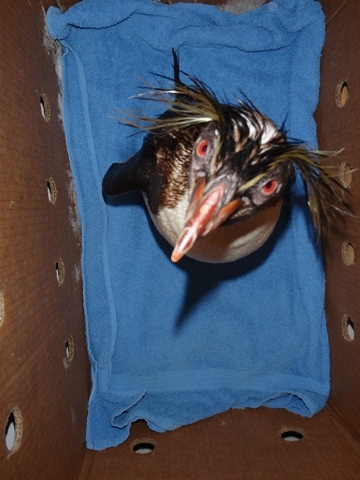 |
| Chicks! |
As usual at SANCCOB, the day started off with the tube feeding, medications and setting up chick living space for the day. Then things got a bit more chaotic! The SANCCOB veterinarian did her rounds throughout all the pens, weighing birds, looking at their overall appearance, checking their medical charts, adjusting medication and treatment plans. It’s something that’s done frequently and allows the staff to grade the medical condition of the birds.
 |
| Checking the health of the birds |
 |
| Weighing birds. This one weighs 2.0 kilograms |
After a close examination, birds from different areas got upgraded! Birds from the ICU came to the chicks area, some of the chicks went to Pen 2 with the big birds. And the two chick pens, the stronger birds and the smaller/”baldies,” were combined into one. Birds were being moved everywhere! And while that is good for the birds, it takes the staff and volunteers a while to sort out who went where and to make changes to medications and treatments that each individual bird receives. But eventually everything was sorted out and things went back to the regularly scheduled program!
 |
| Updating paperwork to track moving birds |
It was a great last day that capped off a great last week. It’s nice to watch the chicks get bigger (one gained 500 grams in five days), become stronger and start to freely take fish from your hand during feeding time! And to know that the most of these birds were abandoned by hungry parents and have an excellent chance of being returned to the wild thanks to SANCCOB is awesome!
 |
| Feeding time |
The day passed quickly as the schedule of feedings (my favorite part of the day) and tube feeding was complimented by swimming and resting time. Soon it was time for the last tube feeding of the day. Three of us worked together to make sure all of the birds got the nutrition that they needed. After feeding everyone and making sure all the birds were settled for the night, it was time to clean my oilskins for the last time. It was hard to process that it was my last time caring for the birds and I’m sure it will hit me tomorrow when I don’t have to go to work. But in the meantime, it’s off to download some more pictures and think about what lies ahead.
 |
| Tubing team! I'm the one in orange |
Learn more about the Southern African Foundation for the Conservation of Coastal Birds, or SANCCOB and their Penguin Chick Bolstering Project.
Follow the adventures of Jo's co-worker, Paul! Aquarium penguin biologist Paul Leonard is also in South Africa to study and care for African penguins in the Southern Hemisphere! Read about his experience on the Penguin Blog.










































